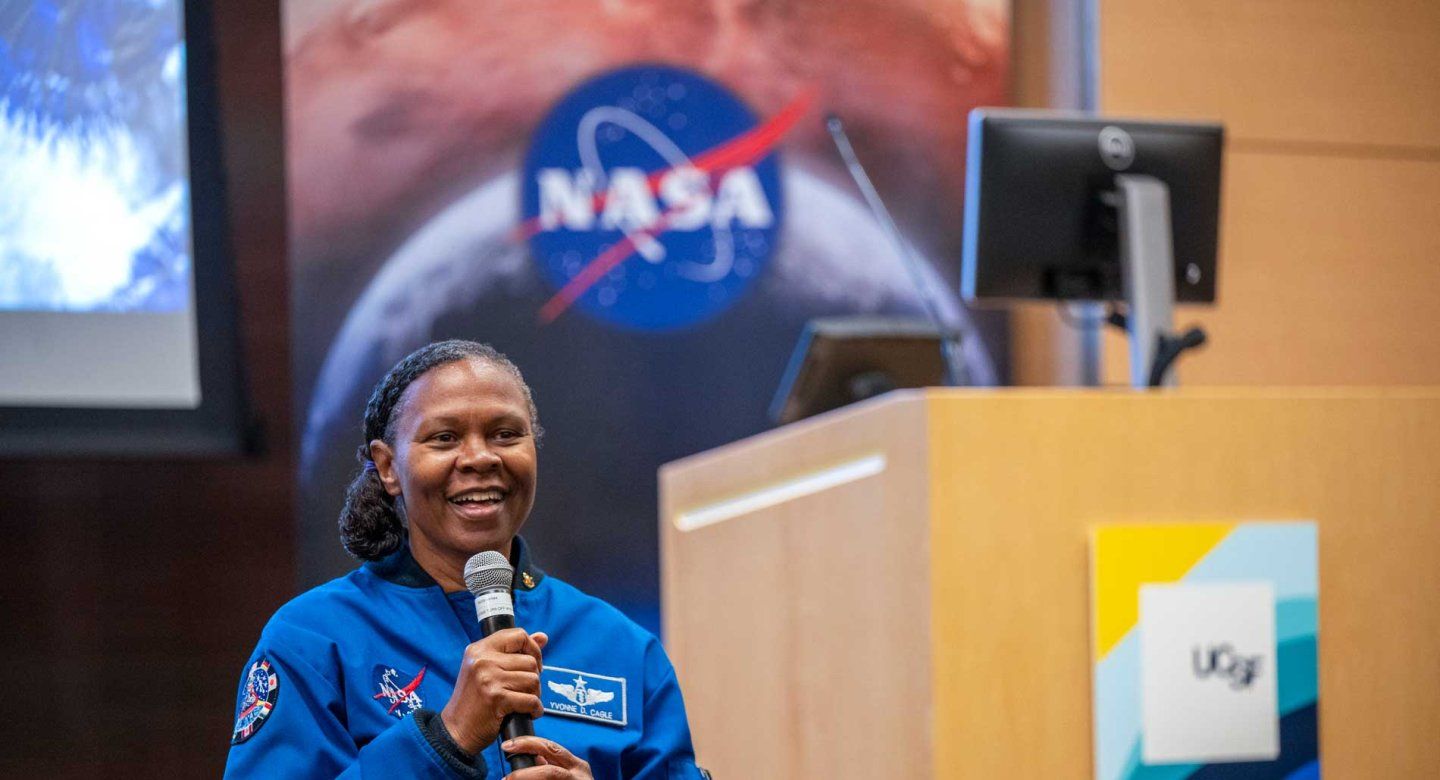UC San Francisco reached into the cosmos at a special gathering with top research and clinical scientists from NASA to explore opportunities to jointly benefit patients on Earth with cancer and other diseases.
The Oct. 4 symposium, featuring top leaders from UCSF, UCSF Health, NASA Johnson Space Center in Houston, NASA Ames Research Center in Silicon Valley and the University of California, included poignant bedside visits with pediatric patients and a scientific roundtable designed to share knowledge and spark medical innovation.
We go to space not just to explore the stars but to improve life here on Earth.”
“This is an incredibly exciting potential partnership,” said UCSF Chancellor Sam Hawgood, MBBS, to about 100 leading cancer researchers, clinicians, space health scientists and other representatives. He made a personal pledge to make the collaboration “both successful and sustainable.”
“At UCSF, our north star is innovation, looking for the next frontier in life sciences and in health care,” Hawgood said. “We understand that we need to challenge ourselves to think boldly, and there’s probably no other organization on the planet that thinks boldly like NASA. I think we’re made for each other.”
The event was hosted by UCSF and held at the San Francisco Mission Bay campus in conjunction with the Biden Cancer Moonshot, a national initiative to halve the nation’s cancer death rate by 2047. Cancer is the country’s second-leading cause of death. In 2016, in the early days of the Moonshot, UCSF hosted cancer officials to discuss fast-tracking novel therapies. NASA joined the initiative in 2022.
“We’ve had collaborations with NASA for years, but this is elevated and revolutionary, and we are building on the strengths of both institutions,” said Sharmila Majumdar, PhD, a UCSF professor and vice chair for research with the Department of Radiology and Biomedical Imaging who was one of the participants discussing the parallel effects of cancer and space flight.
“To update astronaut Neil Armstrong’s famous words when he stepped onto the moon in 1969, this first step for research is a giant leap for cancer and humanity,” she said.
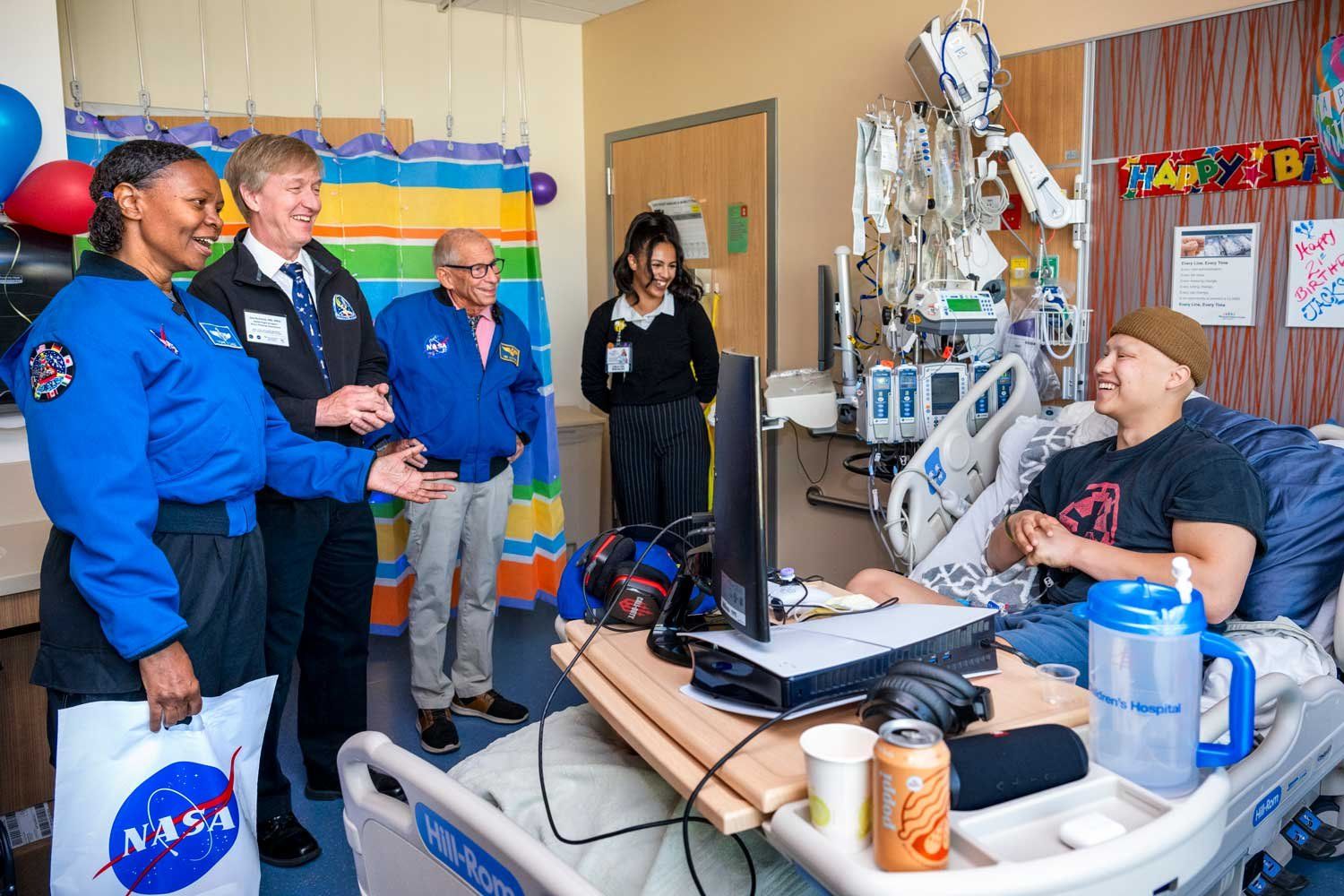
NASA astronauts Yvonne Cagle, Joe Schmid, MD, NASA Flight Surgeon, and Kenneth “Taco” Cockrell visit the oncology ward at UCSF Benioff Children’s Hospital San Francisco.
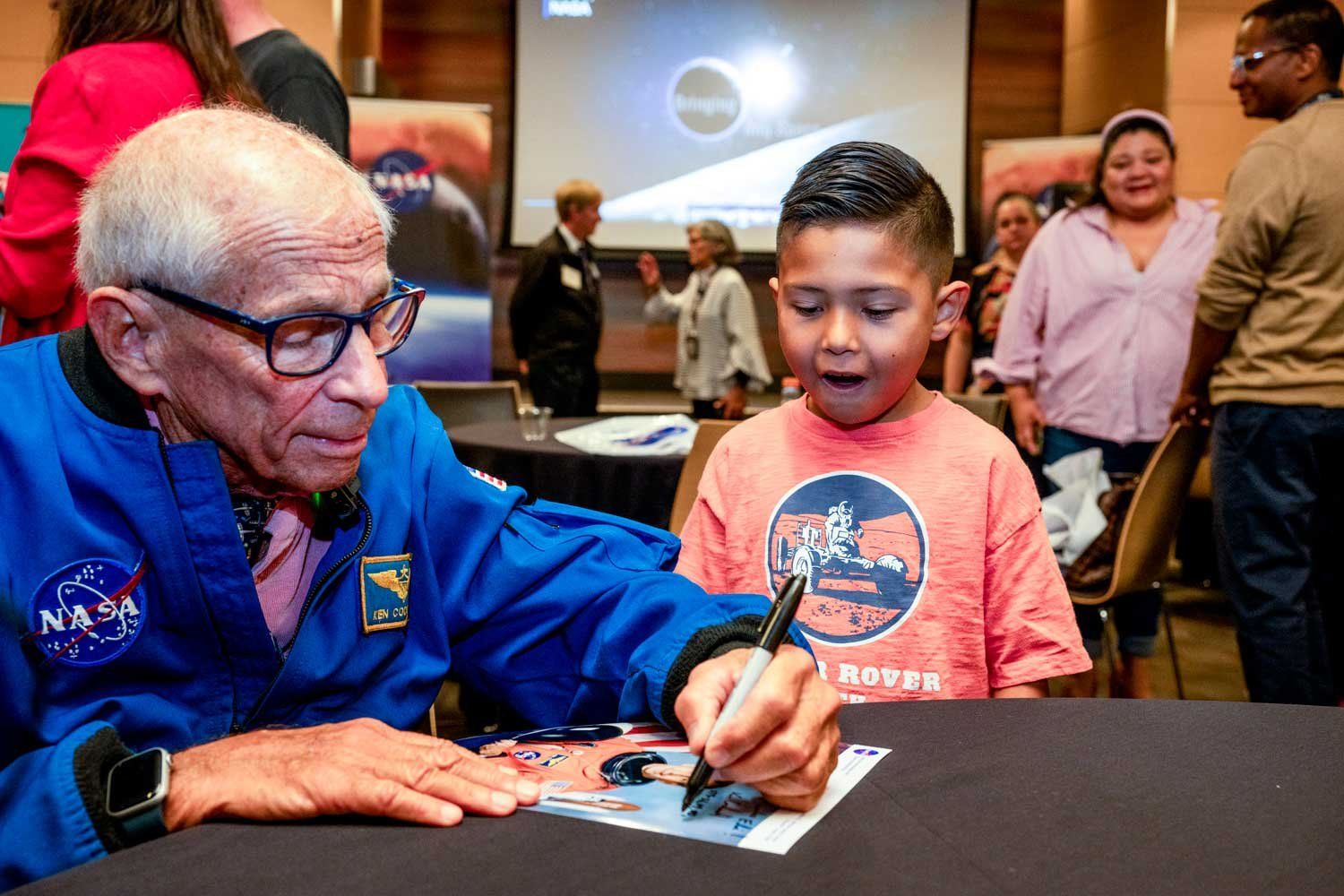
NASA astronaut Kenneth “Taco” Cockrell signs an autograph for a young event attendee.
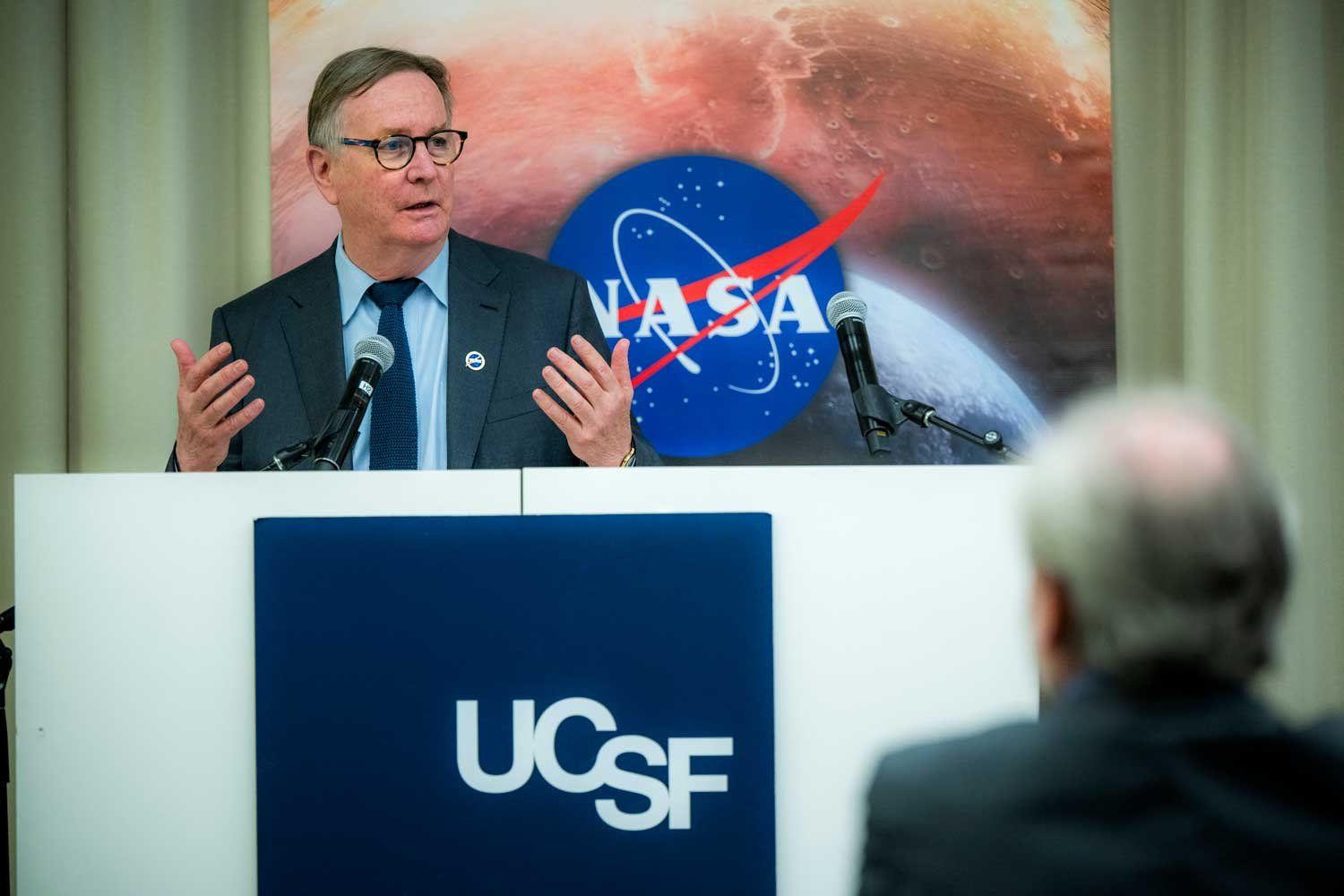
UCSF Chancellor Sam Hawgood speaks at UCSF during a roundtable symposium and breakout sessions led by NASA and UCSF researchers and leaders.
Message from the International Space Station
In a surprise personal greeting from 260 miles above Earth, astronauts aboard the International Space Station sent a recorded message describing the orbiting laboratory’s experiments on protein crystal growth, nanoparticle drug delivery and tissue engineering.
We’re working together to highlight the beneficial impact of space research and development on terrestrial health.”
“We go to space not just to explore the stars but to improve life here on Earth,” said ISS commander Sunita (Suni) Williams.
Alan Ashworth, PhD, FRS, president of the UCSF Helen Diller Family Comprehensive Cancer Center, touted the collective aim to accelerate cancer care.
“NASA and institutions like UCSF are pushing the boundaries of human knowledge daily to improve life for everyone,” he said. “It’s exciting to explore new ways of working together to answer some of our most complex questions about health and well-being on Earth and for astronauts in space,” he said.
Nobel laureate Elizabeth Blackburn, PhD, a UCSF professor emerita in the Department of Biochemistry and Biophysics, delivered the keynote presentation about her pioneering work on telomeres, which contributed to a better understanding of aging and cancer and led to a Nobel Prize in 2009.
Message from the International Space Station
In a surprise personal greeting from 260 miles above Earth, astronauts aboard the International Space Station (ISS) sent a recorded message describing the orbiting laboratory’s experiments on protein crystal growth, nanoparticle drug delivery and tissue engineering.
“We go to space not just to explore the stars but to improve life here on Earth,” said ISS commander Sunita (Suni) Williams.
Alan Ashworth, PhD, FRS, president of the UCSF Helen Diller Family Comprehensive Cancer Center, touted the collective aim to accelerate cancer care.
“NASA and institutions like UCSF are pushing the boundaries of human knowledge daily to improve life for everyone,” he said. “It’s exciting to explore new ways of working together to answer some of our most complex questions about health and well-being on Earth and for astronauts in space,” he said.
Nobel laureate Elizabeth Blackburn, PhD, a UCSF professor emerita in the Department of Biochemistry and Biophysics, delivered the keynote presentation about her pioneering work on telomeres, which contributed to a better understanding of aging and cancer and led to a Nobel Prize in 2009.
We’re working together to highlight the beneficial impact of space research and development on terrestrial health.”
From 260 miles above Earth: NASA astronauts Sunita “Suni” L. Williams and Barry “Butch” E. Wilmore greeted UCSF with a surprise recorded message.
From basic research to patient care
“The joint effort between NASA and UCSF to accelerate cancer research may not seem obvious. However, the challenges endured by humans in space flight are analogous to many of the challenges endured by cancer patients on Earth,” said Aenor Sawyer, MD, a UCSF orthopedist in the UCSF Department of Orthopaedic Surgery and director of UC Space Health who spearheaded and led the event.
The University of California has long pioneered research and innovation propelling human space exploration, and the UC Space Health program focuses on myriad medical and behavioral issues affecting space and bringing knowledge back home. The meeting was also supported by UCSF Innovation Ventures.
In the morning portion at UCSF Benioff Children’s Hospital San Francisco, a delegation from NASA Johnson Space Center, including astronauts Yvonne Cagle, MD, and Kenneth D. Cockrell, a retired veteran of five Space Shuttle missions who disclosed his own bout with multiple myeloma, met with youths in their hospital rooms and also with ambulatory pediatric and adult cancer patients.
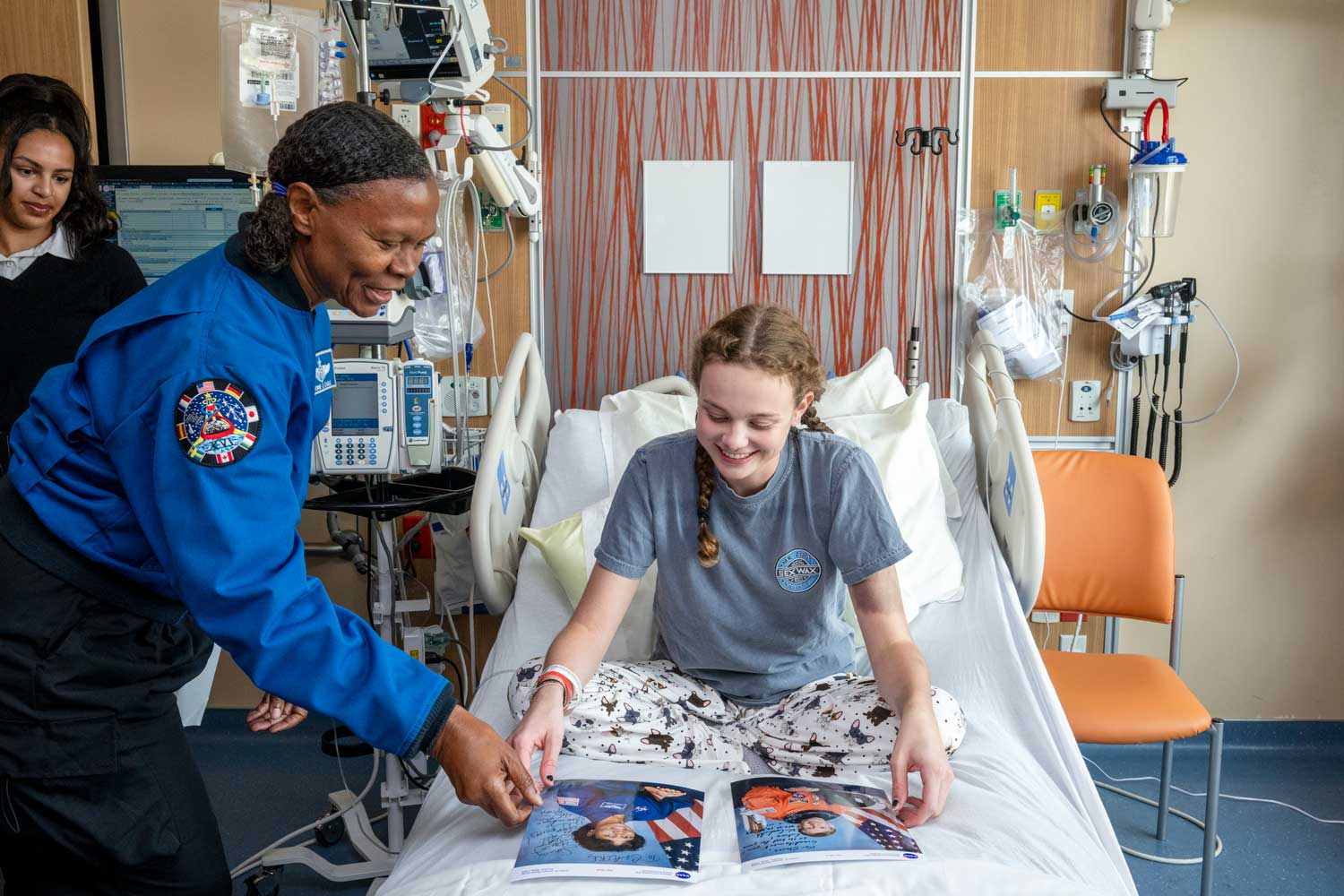
“We are inspired by all of you, your passion, your fight,” said Eugene Tu, PhD, director of NASA Ames Research Center, a 3,000-employee lab started in 1939.
The afternoon scientific roundtable, bridging fields through focused discussion, tackled assorted themes including radiation exposure, isolation, gravity fields, hostile environments and emerging technologies.
“There were over a dozen exciting project ideas that were generated before the day even ended,” said Sawyer. “These and many others will be explored over the next month, and joint scientific NASA and UCSF working groups will be established to move promising projects forward.”
For Mitchel Berger, MD, a UCSF neurosurgeon and director of the UCSF Brain Tumor Center, collaboration is key.
“Leveraging technology is a great advantage to partnering with NASA,” Berger said. “We are thrilled to be part of this and look forward to the great opportunity of working with NASA.”
Vanessa E. Wyche, director of Johnson Space Center, described the “privilege of leading human space flight for the nation.” She applauded the work of UCSF and detailed how joint work benefits patients and caregivers, including NASA’s contributions to magnetic resonance imaging (MRI), one of the most important innovations in medical technology.
Her words quietly resonated with Sergio Canjura, a UCSF Health patient in San Francisco who has battled brain cancer and related conditions for many years.
“I’ve had too many MRIs to count,” he said. “Hearing about them brought back the feeling, the fear, what it felt like to be in an MRI. It helped me make a direct connection. This has been such an amazing experience.”
From basic research to patient care
“The joint effort between NASA and UCSF to accelerate cancer research may not seem obvious. However, the challenges endured by humans in space flight are analogous to many of the challenges endured by cancer patients on Earth,” said Aenor Sawyer, MD, a UCSF orthopedist in the UCSF Department of Orthopaedic Surgery and director of UC Space Health who spearheaded and led the event.
The University of California has long pioneered research and innovation propelling human space exploration, and the UC Space Health program focuses on myriad medical and behavioral issues affecting space and bringing knowledge back home. The meeting was also supported by UCSF Innovation Ventures.
In the morning portion at UCSF Benioff Children’s Hospital San Francisco, a delegation from NASA Johnson Space Center, including astronauts Yvonne Cagle, MD, and Kenneth D. Cockrell, a retired veteran of five Space Shuttle missions who disclosed his own bout with multiple myeloma, met with young people in their hospital rooms and also with ambulatory pediatric and adult cancer patients.

“We are inspired by all of you, your passion, your fight,” said Eugene Tu, PhD, director of NASA Ames Research Center, a 3,000-employee lab started in 1939.
The afternoon scientific roundtable, bridging fields through focused discussion, tackled assorted themes, including radiation exposure, isolation, gravity fields, hostile environments and emerging technologies.
“There were over a dozen exciting project ideas that were generated before the day even ended,” said Sawyer. “These and many others will be explored over the next month, and joint scientific NASA and UCSF working groups will be established to move promising projects forward.”
For Mitchel Berger, MD, a UCSF neurosurgeon and director of the UCSF Brain Tumor Center, collaboration is key.
“Leveraging technology is a great advantage to partnering with NASA,” Berger said. “We are thrilled to be part of this and look forward to the great opportunity of working with NASA.”
Vanessa E. Wyche, director of Johnson Space Center, described the “privilege of leading human space flight for the nation.” She applauded the work of UCSF and detailed how joint work benefits patients and caregivers, including NASA’s contributions to magnetic resonance imaging (MRI), one of the most important innovations in medical technology.
Her words quietly resonated with Sergio Canjura, a UCSF Health patient in San Francisco who has battled brain cancer and related conditions for many years.
“I’ve had too many MRIs to count,” he said. “Hearing about them brought back the feeling, the fear, what it felt like to be in an MRI. It helped me make a direct connection. This has been such an amazing experience.”
